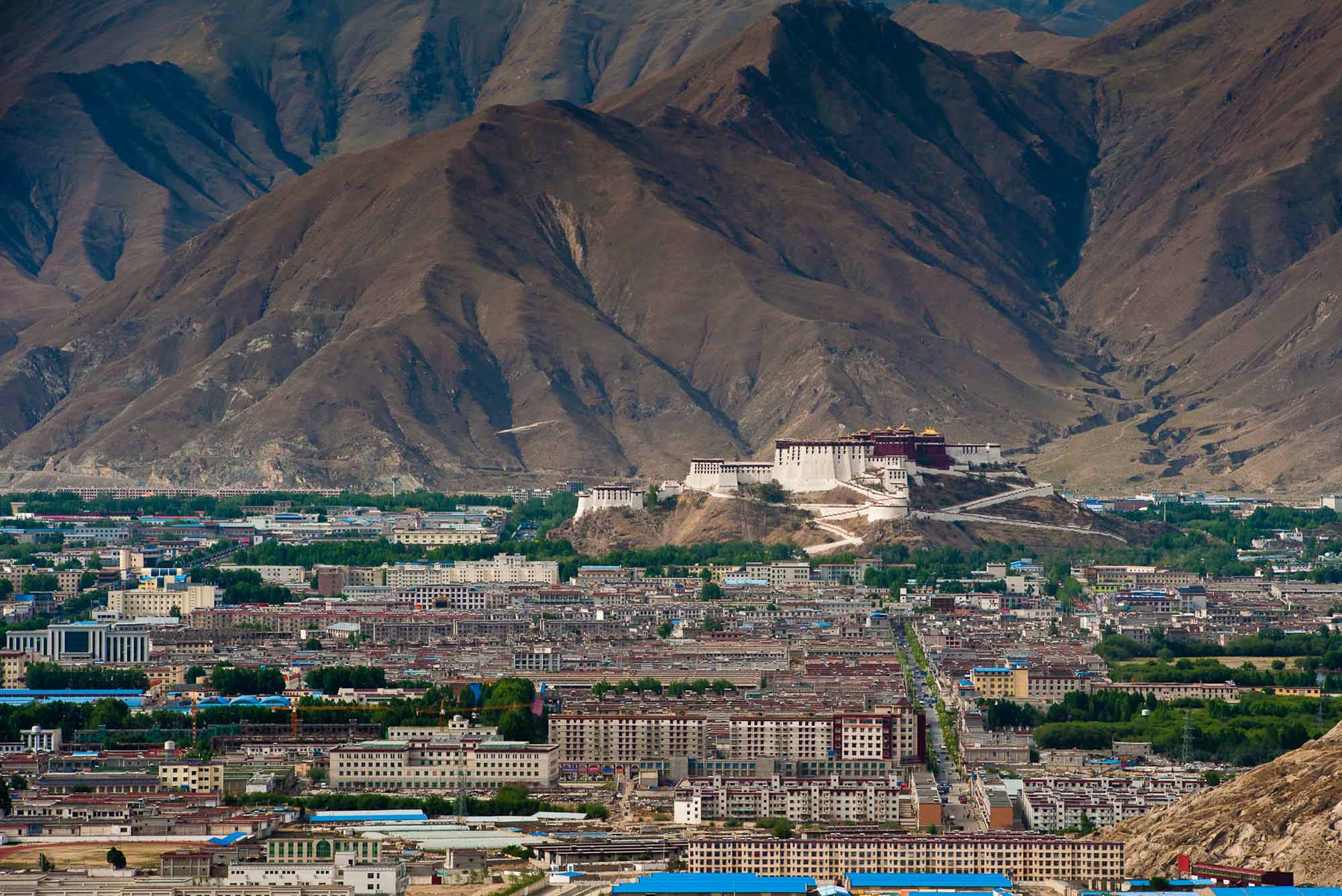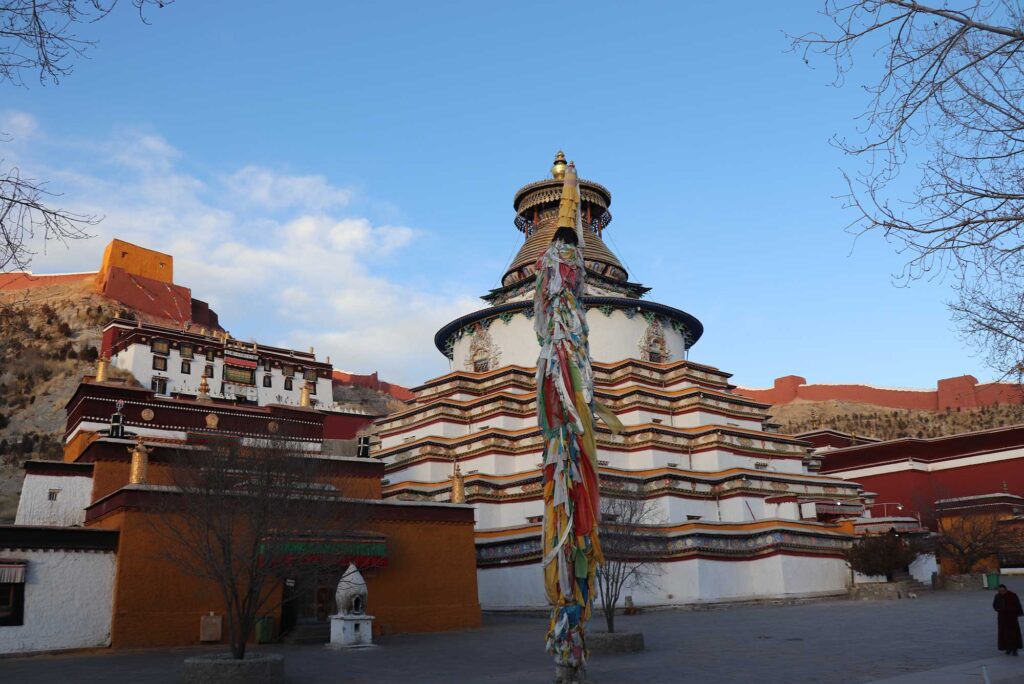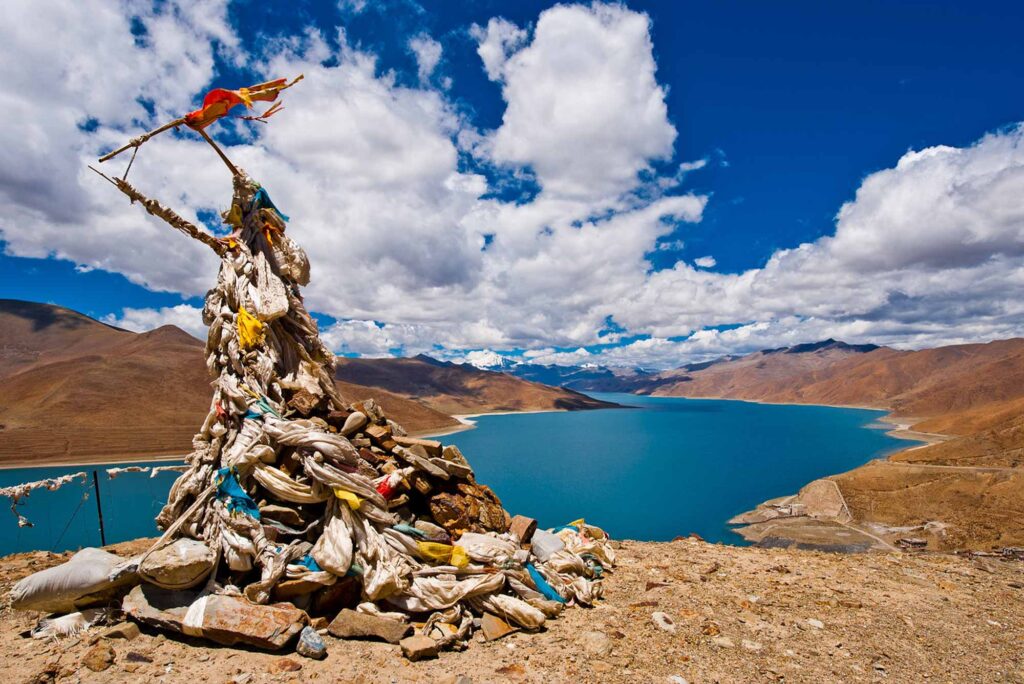Chengdu to Lhasa overland Tour’s Details
The Chengdu to Lhasa overland Tour route is an exceptional Tibet overland tour, considered one of the finest options available. With a total distance of 2,412km, this remarkable journey begins in Chengdu in the east and concludes in Lhasa, Tibet, to the west. It provides an excellent means of traveling from Chengdu to Tibet.
As you embark on this route, you will encounter several notable centers of Khampa culture, such as Kangding and Lithang. The road continues its path into Lhasa, offering breathtaking views of the majestic mountains within the alpine fertile valley of Pasho and Lulang. Additionally, you will be treated to awe-inspiring sights of Ranwu Lake and Basum Lake.
The Sichuan-Tibet highway spans 14 imposing mountains, averaging an altitude of 4500m. It traverses numerous renowned rivers, primeval forests, and captivating villages. The winding path, characterized by narrow and rocky terrain, steep slopes, and sharp ridges, presents spectacular vistas of nomadic communities on the vast plateau grasslands. Moreover, you will be captivated by the picturesque sceneries of lakes and snow-capped peaks nestled within the beautiful fertile valleys. The journey unfolds westward, leading you to Lhasa, where you can explore the city’s world heritage sites and mystical temples, leaving you astonished and deeply appreciative.
This thrilling adventure is most accessible during the months of April to mid-June and September to November. During this time, the eastern part of the route enjoys a mild climate, thanks to the influence of monsoon winds and precipitation from Southeast Asia. It is worth noting that the period from the end of June to August experiences monsoon rainfall, which can cause road damage.
We hope this description provides a clear overview of the splendid Chengdu to Lhasa overland Tour route. It is a journey characterized by its simplicity, politeness, and professionalism, offering an unforgettable experience in Tibet

Tour Itinerary of Chengdu to Lhasa overland Tour
DAY 01: ARRIVE AT CHENGDU, EITHER BY AIR OR TRAIN
Upon your arrival at Chengdu International Airport, our representatives will warmly welcome you. A short 30-minute drive will take you to your hotel in downtown Chengdu. Take some time to rest and overcome any jet lag. Overnight in Chengdu.
DAY 02: HALF-DAY ESCORTED TOUR TO GIANT PANDA BREEDING CENTRE
Attraction: Giant Panda Breeding Centre, featuring adorable giant pandas and red pandas.
This morning, our guide and driver will meet you at the hotel lobby at around 8 am to begin a delightful day with a visit to the Panda Breeding Centre. The morning hours are particularly lively, as you will witness the cute pandas rolling, climbing, and enjoying their bamboo meals. Established in 1987 with 6 rescued pandas, the Chengdu Giant Panda Breeding Centre now houses around 83 pandas. During your visit, you will have the opportunity to observe both giant pandas and red pandas. The nursery area will surely leave a lasting impression with its newly born panda cubs. After lunch, you can take the time to pack and prepare for your long overland journey across the Tibetan plateau. This afternoon, you will meet your Tibetan guide and driver to confirm the departure time for your trip. Overnight in Chengdu.
DAY 03: CHENGDU - YA'AN - LUDING - KANGDING, 380km, 7 to 8 hours' drive
Attractions: Chengdu countryside view, Kangding Tibetan town nestled in a narrow valley.
Today, we will drive to Kangding via Ya’an and Luding. The well-paved highway extends until Ya’an, after which the road becomes winding and narrow within the gorge, occasionally taking longer than expected. Continuing through the Mt. Erlang (3437m) tunnel, you will follow the upstream river to Kangding. Kangding serves as the capital of Ganzi Tibetan Prefecture, but in recent years, more Chinese merchants have settled there, adding to the town’s cultural diversity. The river flowing through the town plays a significant role during sunny summer days. After dinner, you can take a short stroll around the streets. Overnight in Kangding
DAY 04: KANGDING (2395m) - LITHANG (4041m), 300km, 6 hours' drive
Attractions: Mt. Zheduo (4270m), vast nomadic pastures, blooming wildflowers, mighty snow-capped peaks.
Today, we will drive across the Zheduo Pass (4270m), marked by a heap of prayer flags and a stupa. Tibetan pilgrims consider these passes as sacred spots and adorn them with prayer flags. Driving further into the valley, you will pass by the recently opened Kangding Airport. Before reaching XinduQiao, you will be enchanted by the colorful triangular prayer flags and intricately carved mantras adorning the hillsides along the road. Among Chinese tourists, XinduQiao is renowned as a photographer’s paradise, especially in spring when the yellowish leaves of the roadside trees create a picturesque scenery resembling a great painting. As we continue driving through mountain ranges, we will encounter natural lakes and solitary nomadic family tents surrounded by herds of sheep and yaks grazing on peaceful pastures. On the way to Lithang, we will cross the Jainzi Wan Pass (4659m) and experience the unique sensation of driving on the roof of the world as we follow the ridge. Eventually, we will arrive at our destination for the day, Lithang, located in a high valley and famous as the birthplace of the 7th and 10th Dalai Lamas. Upon arrival, you can check in at the hotel and explore the local streets for the remainder of the day. Overnight in Lithang.
DAY 05: LITHANG - BATHANG (2580m) - MARKHAM (3875m), 293km, 6 hours' drive
Attractions: Plateau nomads and snow-capped mountains, Yangzi River (Drichu), and beautiful valleys.
Continuing our westward journey, we drive towards Markham via Bathang. The wide grasslands of this region are home to hundreds of nomads and their herds. During the end of July and August, wild blossoms transform the pasture into a vast garden. After a short drive from Bathang County, we will cross the Yangzi River bridge, which marks the border of the Tibet Autonomous Region. At the end of the bridge, the checkpoint will inspect your documents and permits to enter TAR. The road then winds through deep gorges, offering endless views of mountains and valleys that beg for photographic stops. As we reach Markham, the road intersects with the Yunnan-Tibet Highway. You will spend the night in Markham and have the opportunity to explore the local bazaar after dinner. Overnight in Markham.
DAY 06: DRIVE FROM MARKHAM TO BASHO VIA ZUGONG AND PAMDA
Today, we will embark on a scenic drive from Markham to Basho, passing through picturesque Tibetan villages and enjoying stunning views of mountains and the Mekong River. Our route will take us over the Dongdo-la, the highest point of the entire journey, standing at an altitude of 5,108 meters. As we continue along the road, we will follow the Yachu River, a tributary of the Salween River, until we reach Pamda. Here, we will encounter a spur road that leads to Chamdo. From Pamda, we will traverse the unpaved road over the Nujiang Mountain, situated at 4,658 meters. This stretch of the journey includes a section with 72 bends, which can be challenging due to the dusty conditions. However, the breathtaking scenery of villages nestled along the stream and the surrounding mountains makes the drive worthwhile. Finally, we will arrive in the small town of Basho, conveniently located by the roadside, offering a comfortable place to spend the night. Overnight in Basho
DAY 07: DRIVE FROM BASHO TO POMI VIA RANWU
Today’s drive will take us from Basho to Pomi, with a stop at the stunning Ranwu Lake along the way. As we descend in altitude, the climate transitions from dry to moist, resulting in lush green valleys and dense forests lining the road. When we reach Ranwu, we will pause for a while to admire the breathtaking beauty of Ranwu Lake. The pristine lake offers a captivating reflection of the snow-capped mountains, providing ample opportunities for stunning photographs. Continuing our journey, we will drive for a few kilometers alongside the lake before proceeding to Pomi. Overnight in Pomi.
DAY 08: DRIVE FROM POMI TO NYINTRI (BAYI) VIA TONGMI AND LULANG
Today’s drive will lead us through the picturesque green valleys as we make our way from Pomi to Nyintri (Bayi). Along the way, we will pass through Tongmi and Lulang, where we will be treated to the sight of alpine forests and majestic snow-capped mountains, including the imposing Mt. Namcha Barwa (7,787m) and Mt. Gyala Palri (7,151m). The road traces the upstream paths of the Parlung River and Rongchu River, allowing us to witness the unique beauty of the region. We will cross the Yigong Tsangpo on a photogenic suspension bridge before ascending through a series of switchbacks to the Serkym La Pass (4,582m). At the pass, we will stop at the Serkym La scenic spot, offering panoramic views of the Rongchu Valley and the towering mountains in the background. Afterward, we will drive approximately 60km to reach Nyintri town. Overnight in Nyintri.
DAY 09: DRIVE FROM NYINTRI (BAYI) TO LHASA VIA BASUM TSO
Today, we will drive alongside the Nyanchu River, passing through charming alpine valleys and typical Tibetan villages on our way to Lhasa. Along the route, we will have the opportunity to visit Basum Tso, a beautiful alpine lake located approximately 50km from the main road. The lake is not only known for its sheer beauty but also for its connections to semi-mythical figures such as the Kham-King Gesar and the Indian abbot Guru Rinpoche. Stories and legends surrounding the surrounding snow-capped peaks add to the mystical atmosphere of the area. We will walk across a floating bridge to visit the historical Nyinmapa Monastery on the island in the lake. In the afternoon, we will continue driving west, crossing over the Mila Pass (5,000m) and experiencing a gradual increase in altitude. As we approach Lhasa, the landscape will transform into the characteristic dry plateau climate, with bare mountains dominating the scenery. Along the Lhasa River, we will catch glimpses of the majestic Potala Palace, an iconic landmark perched above the rest of the city. Overnight in Lhasa.
DAY 10: ESCORTED TOUR OF LHASA
Today marks your first day on the high plateau, and it is common for some travelers to experience a mild headache due to the altitude. To acclimatize, it is essential to stay hydrated and engage in light activities during the initial days. In the morning, our guide will meet you at the hotel, and we will embark on an easy visit to the Jokhang Temple, located in the heart of the Old Lhasa city. The Jokhang Temple holds great significance and is always bustling with devoted local pilgrims. After exploring the temple, you will have time to wander around the Bakhor Street, a renowned devotional circuit and a bustling market in Lhasa. While it was once a famous local market, it has now transformed into a center for tourist gift shopping. In the afternoon, we will visit the world-famous Potala Palace, a magnificent architectural masterpiece and a symbol of Tibetan culture. Originally built in the 7th century by King Songtsen Gampo and later restored by the 5th Dalai Lama in the 17th century, the Potala Palace served as the residence of the Dalai Lama and his government. Take the rest of the day to further acclimatize and alleviate jet lag. Overnight in Lhasa.
DAY 11: ESCORTED TOUR OF LHASA
Today, we will embark on an escorted tour of Lhasa, visiting two prominent monasteries: Drepung Monastery and Sera Monastery. In the morning, we will explore Drepung Monastery, which was once the largest monastery in the world, accommodating over 10,000 monks. Despite experiencing some destruction over time, the monastery still offers a captivating glimpse into its rich history. As we walk through the narrow and winding lanes that weave through the monks’ living quarters, it feels like stepping into a traditional village. The day continues with a visit to Sera Monastery, founded in the fifteenth century by Jamchen Choji Sakya Yeshi, a disciple of Tsongkhapa. Sera Monastery houses several monastic colleges and is home to hundreds of monks from various parts of Tibet. One of the monastery’s highlights is the famous Buddhist philosophical debates, which take place in the afternoon (except on Sundays). After the day’s exploration, take the remainder of the day to acclimatize and rest. Overnight in Lhasa.
DAY 12: DAY TRIP TO NAMTSO LAKE (4700m), 500km, 8.5 hours
Today, we will embark on a day trip to Namtso Lake, located northwest of Lhasa. Our journey follows the Qinghai-Tibet Highway, tracing the Tibet train track until Damshong, and then continuing westward to Namtso Lake. This region, known as Jiangthang or the Northern Nomads’ Land, features vast pastures that have served as the grazing grounds for plateau nomads for generations. As we cross the Lagen La Pass (5190m), we will be rewarded with a breathtaking vista of Namtso Lake. Driving along the paved road, we will pass through the nomad grasslands, where during the summer season, black tents belonging to nomad families can be spotted along the roadside. Our destination is the Tashi Do Peninsula, where you will have ample time in the afternoon to explore the surroundings and soak in the natural beauty of Namtso Lake. Considered one of Tibet’s three holiest lakes, Namtso Lake holds great spiritual significance for Tibetans, who undertake month-long pilgrimages to circumambulate its shores. With a length of 70km and a breadth of 30km, it is the world’s highest saltwater lake and the second largest in China. Before returning to Lhasa in the late afternoon, we will visit a nomad family, giving you a firsthand experience of their yak wool tents and an opportunity to gain insight into their unique lifestyle. Overnight in Lhasa.
DAY 13: DEPARTURE FROM LHASA AIRPORT/ TRAIN STATION
Today, our guide and driver will accompany you to the airport or train station in Lhasa, marking the end of our journey together. It is time to bid farewell and embark on your onward journey. We sincerely hope you had a memorable experience exploring Tibet.
Tour Services of Chengdu to Lhasa overland Tour
Included
- All necessary Tibet travel permits.
- Entrance ticket for all the attractions listed in the itinerary.
- Entrance for your Vehicle and guide for the Everest Natural Reserve.
- Private transportation in Tibet with experienced local Tibetan driver: Ranging from Business van to minibus depending on the group size.
- English speaking Proffesional Tour guide (Local Tibetan).
- Lodging in three star rating hotels: Hotel rooms are based on double occupancy ( with Breakfast).
- Free shuttle Pick-up and send-off services at the beginning/end of the tour.
- A mobile with local SIM card during the tour with your tour guide (it can receive international calls and text messages).
- An Oxygen tank and First Aid box in Car (Size of Oxygen Tank base on group member).
- Two water bottle each day/person.
- Lodging and meals for guide and drivers.
Excluded
- Travel insurance which covers tour cancellation and emergency evacuation (highly recommended to buy from your home country).
- Chinese Visa or Tibet Group Visa ( If coming from Nepal).
- International and domestic flight/train tickets.
- Lunches and Dinners averagely a meal in Tibet (Around USD5 per person).
- Gratuities (Tips) for the guide and driver. ( Highly recommend to give at end of tour).
Chengdu to Lhasa overland Tour’s Map

Conclusion of Chengdu to Lhasa overland Tour
In conclusion, our journey from Chengdu to Lhasa has been an extraordinary adventure filled with breathtaking landscapes, cultural encounters, and spiritual discoveries. From the vibrant cityscape of Chengdu to the awe-inspiring beauty of Tibet, we have experienced a diverse range of attractions and immersed ourselves in the unique charm of this region.
As we traversed the rugged terrain, we encountered picturesque Tibetan villages, offering us glimpses into the traditional way of life in this remote corner of the world. The stunning views of majestic mountains and the meandering Mekong River left us in awe of nature’s grandeur.
Crossing the Dongdo-la, the highest point of our journey, and journeying along the Yachu River and Salween River, we witnessed the untamed beauty of Tibetan landscapes. The dusty road with its 72 bends leading us through the Nujiang Mountain challenged us, but the reward of reaching the small town of Basho made it all worthwhile.
The green valleys, snow-capped mountains, and the serene Ranwu Lake captivated our senses as we made our way to Pomi. Driving through alpine forest valleys in Lulang, with the magnificent Mt. Namcha Barwa and Mt. Gyala Palri in the backdrop, provided us with unforgettable moments of tranquility.
Our exploration continued to Basum Lake, an alpine gem connected to fascinating legends and surrounded by lush valleys and typical Tibetan villages. The glimpse of the iconic Potala Palace in Lhasa, perched majestically over the city, stirred a sense of wonder and reverence within us.
In Lhasa, we delved into the heart of Tibetan Buddhism, visiting sacred sites like Jokhang Temple and the world-famous Potala Palace. The bustling Bakhor Street offered a blend of devotion and commerce, reflecting the evolving character of the city.
Our escorted tour took us to Drepung Monastery and Sera Monastery, where we immersed ourselves in the spiritual traditions and witnessed the passionate Buddhist philosophical debates among the monks.
The climax of our journey was the day trip to Namtso Lake, a place of unparalleled beauty. The vast grasslands, the Thangula Range, and the nomad families provided us with a deeper understanding of the region’s nomadic culture and the significance of this holy lake.
As we bid farewell to Lhasa and each other, we carry with us the memories of this incredible journey. The friendly encounters, the natural wonders, and the spiritual insights have left an indelible mark on our hearts.
We extend our heartfelt gratitude to our knowledgeable guides and skilled drivers who ensured our safety and shared their deep knowledge of the region with us. Their professionalism and dedication made this journey truly exceptional.
May the memories we have created during this journey from Chengdu to Lhasa inspire us to seek further adventures, cherish cultural diversity, and embrace the beauty of our world. Until we meet again on our next voyage, we wish you all safe travels and abundant joy in your future endeavors.
FAQs of Chengdu to Lhasa overland Tour
Q: How long does the Chengdu to Lhasa tour typically last?
A: The Chengdu to Lhasa tour typically lasts for approximately 13 days, allowing ample time to explore the stunning landscapes, cultural sites, and spiritual destinations along the route.
Q: What are the main attractions included in the Chengdu to Lhasa tour?
A: The Chengdu to Lhasa tour includes a range of captivating attractions such as typical Tibetan villages, breathtaking mountain views, the Mekong River, Drepung Monastery, Sera Monastery, Jokhang Temple, the iconic Potala Palace, Namtso Lake, and more.
Q: Is the tour suitable for people with altitude sickness concerns?
A: While the tour involves traveling through high-altitude areas, we take precautions to ensure the comfort and safety of our travelers. It’s important to acclimatize gradually and follow our experienced guides’ recommendations regarding hydration and mild activity to alleviate altitude sickness symptoms.
Q: What is the best time of year to embark on the Chengdu to Lhasa tour?
A: The best time to embark on the Chengdu to Lhasa tour is typically during the spring (April to June) and autumn (September to November) seasons when the weather is generally mild and stable. However, it’s important to note that weather conditions can vary, and it’s advisable to check with our tour operators for the most up-to-date information.
Q: What level of physical fitness is required for this tour?
A: The Chengdu to Lhasa tour involves some road travel, walking, and occasional climbs in altitude. While it doesn’t require a high level of physical fitness, a moderate level of fitness and mobility is recommended to fully enjoy the tour’s activities and explore the attractions comfortably.
Q: Are vegetarian or special dietary requirements accommodated during the tour?
A: Yes, we can accommodate vegetarian and special dietary requirements. Please inform us in advance, and we will make the necessary arrangements to ensure your dietary needs are taken care of during the tour.
Q: Is travel insurance necessary for the Chengdu to Lhasa tour?
A: Yes, we strongly recommend obtaining travel insurance that covers medical expenses, trip cancellations or interruptions, and any unforeseen circumstances. It’s essential to have adequate coverage to provide peace of mind during the tour.
Q: Can additional days or customized itineraries be arranged?
A: Yes, we offer flexibility in our tour arrangements. If you wish to extend your stay or have specific customization requests, please let us know, and we will work with you to design a tailored itinerary that meets your preferences and interests.
Q: What languages are spoken by the tour guides?
A: Our tour guides are fluent in English and Mandarin Chinese. They will accompany you throughout the journey, providing insightful commentary, assistance, and ensuring a smooth and enjoyable travel experience.
Q: What should I pack for the Chengdu to Lhasa tour?
A: It is recommended to pack comfortable and layered clothing suitable for varying weather conditions, including warm clothing for cooler temperatures, as well as rain gear. Additionally, essentials such as sunscreen, a hat, comfortable walking shoes, and personal medications should be included in your packing list.


